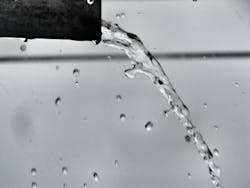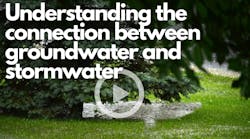Sam Smith has dedicated his professional life not only to carrying out foundation repair for Regional Foundation Repair but also to staying up to date on new foundation technologies and repair methods. His years of educational and hands-on experience help Regional Foundation Repair remain one of the most accurate and useful foundation resources for homeowners across the country. Smith can be reached at [email protected].
Managing storm water in a way that isn’t detrimental to the environment and your neighbors’ properties can be challenging. Add in the fact that rainwater can cause severe damage to your foundation and pollute drinking water, and your decision on how you redirect runoff becomes even more complicated.
Below, we’ll discuss the top three ways homeowners can redirect water away from the home foundation while controlling runoff leaving the property. These strategies will reduce runoff, help to keep storm water systems from overflowing or getting damaged, and prevent our water sources from getting contaminated. We’ll also discuss some of the common pitfalls homeowners experience with each strategy and how each could be detrimental to hydrologies if implemented improperly.
Strategy #1: Install a French Drain, But Do It Properly
A French drain is an irrigation tool that is meant to collect water from the soil near the home’s foundation and move it to a safe place for disposal. Typically, these systems consist of a corrugated and perforated PVC pipe set under gravel and a few inches of soil. The idea behind this system is to have rainwater soak into the ground, drip onto the gravel bed, and then fall through a geotextile fabric and into the pipe to be removed.
There are a few significant downsides to French drains, and they don’t work in every situation. One of the primary issues with these drainage systems is that the drain pipe needs to have an adequate slope to move water appropriately.
Many French drain installers fail to use the correct slope, which is about a ¼ inch drop for every linear foot. When installed improperly, French drains will fail to relocate water. Ensuring the drain pipes have the correct slope is crucial if the French drain is to function and redirect runoff appropriately.
One of the most significant issues with French drains is that they need to lead the water somewhere that is safe for disposal. Some contractors simply route them to a different area on the property, but drainage beyond this point needs to be considered.
Lawn irrigation systems like French drain can be problematic if they aren’t appropriately drained, as they can contribute to surface drainage problems, pavement deterioration and flooding of storm water systems set into curbs.
Some of the best options are to allow the French drain to route water to an above-ground area where soil saturation won’t be an issue. This is only reasonable if the property is naturally sloped, as the drain pipe needs to be angled downward to move water appropriately. Additionally, the homeowner should find an area that won’t contribute to surface drainage issues elsewhere in the neighborhood.
Ultimately, a properly installed French drain can minimize the stress placed on a storm water collection system and reduce the risk of aquifers and other water sources getting contaminated.
Many homeowners successfully route their French drains to existing storm water drain pipes. Most municipalities require a permit to do this, partially in an effort to make sure these drains don’t become inundated with runoff to the point where they overflow. While this solution is convenient for the homeowner, it does put additional stress on storm water systems.
If the homeowner has the means to route their French drain to a storm water pipe or to an above-ground portion of the property, the system can be an effective way of redirecting water away from the foundation. However, the homeowner or the contractor must take great care to ensure the slope of the pipe is sufficient.
Strategy #2: Use Gutters and Downspouts
Gutters and downspouts are excellent methods for moving water away from a home foundation. Rainfall on the roof naturally drips directly next to the foundation, creating various issues like hydrostatic pressure, differential settling and erosion. Eventually, the added runoff will leave the property after the soil is sufficiently saturated and contribute to storm water system issues. Gutters serve to catch the water from the roof and route it toward your downspouts.
A critical error many homeowners make with their downspouts is failing to drain them appropriately. If the leaders simply drain at the area where they reach the base of the home, the water will naturally collect against the foundation and create issues. This is especially true in areas where expansive clay soil is prevalent.
Many homeowners opt for downspout extensions, which relocate runoff to another part of the property, where saturated soil isn’t as much of an issue. This is often a suitable system in areas that receive below-average rainfall, but excessive rain can inundate properties equipped with downspout extensions.
Some homeowners opt to install an underground drainage system that collects water from downspouts and routes it toward an existing storm water drain pipe or to the street. These are helpful for limiting the damage rainwater causes to foundations, but they can be problematic for the municipality’s storm water management systems.
Some of the best solutions for limiting the negative effects of gutter systems include using rain barrels or collection systems to collect and treat rainwater where it falls. Some residents who use rain collection and treatment systems can then use the water for domestic use or watering grass and plants during dry periods. Most importantly, the collection tanks keep excessive runoff away from the home’s foundation, even in areas with above-average rainfall.
Rain collection is especially helpful in areas where the ground is less absorbent, which makes dealing with storm water more challenging. Some cities offer rebates on storm water management costs to homeowners who implement collection systems because they significantly reduce the strain on storm water management systems.
Strategy #3: Install a Swale on the Property
Finally, a homeowner can opt to install a swale on their property to help redirect water away from the foundation. A swale is a depression in the landscaping where water can collect naturally and safely. Most homeowners who install swales grade their property toward the depression to entice runoff to move into the shallow basin.
Wet swales in areas with heavy rainfall are often filled with aquatic plants that help prevent erosion along the slopes. Dry swales are often used in cities where rain may be infrequent, but is excessive at times. Dry swales can be planted with some plant species and decorated to make them look appealing even when they aren’t full.
Many homeowners use swales in combination with gutter drainage systems and French drains, as the drain pipes can lead directly to the depression for water collection. It’s crucial to size the swale appropriately so that it will be able to handle the amount of runoff expected on your property.
Not only will the basins keep water away from the home, but they also prevent the homeowner from having to drain runoff toward the street. As such, swales help keep cities’ storm water drainage system from getting inundated, reduce the risk of water sources getting contaminated, and prevent excessive runoff from damaging the pavement.
Just like with rainwater collection and treatment from downspouts, some cities may offer reduced rates for storm water management to residents who implement swales on their properties.
Why Residential Storm Water Management Is Important
Most homeowners think first about their foundation when considering how to redirect water away from their homes. Excessive rainfall can saturate the soil, putting intense hydrostatic pressure on the concrete and contributing to differential settlement of the foundation.
Unfortunately, homeowners also have to consider the effects of their drainage systems on their city’s storm water management system. Some of the best options for redirecting water away from foundations — including French drains and gutter systems — can inadvertently lead to issues with pavement deterioration and potentially inundate the storm water management system to the point of overflowing or backing up.
Because the large majority of land is occupied by residents whose homes contribute to storm water management issues, it’s crucial for homeowners to help manage storm water and reduce the risks associated with excess or uncontrolled runoff.
The three best options for redirecting water away from home foundations include French drains, gutter systems and swales. However, all of these options require professional installation to ensure they function as intended and drain or collect water in a responsible manner.






